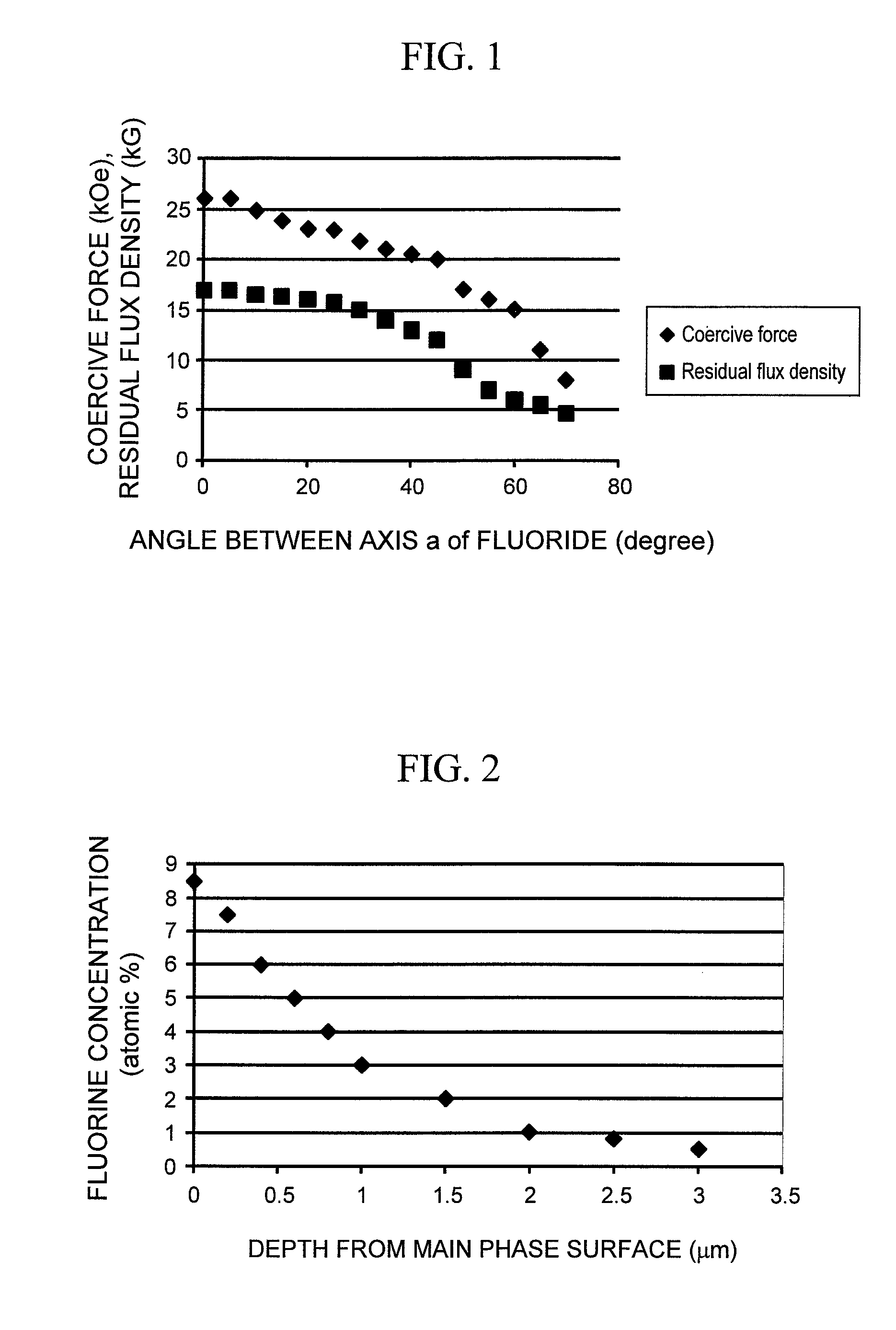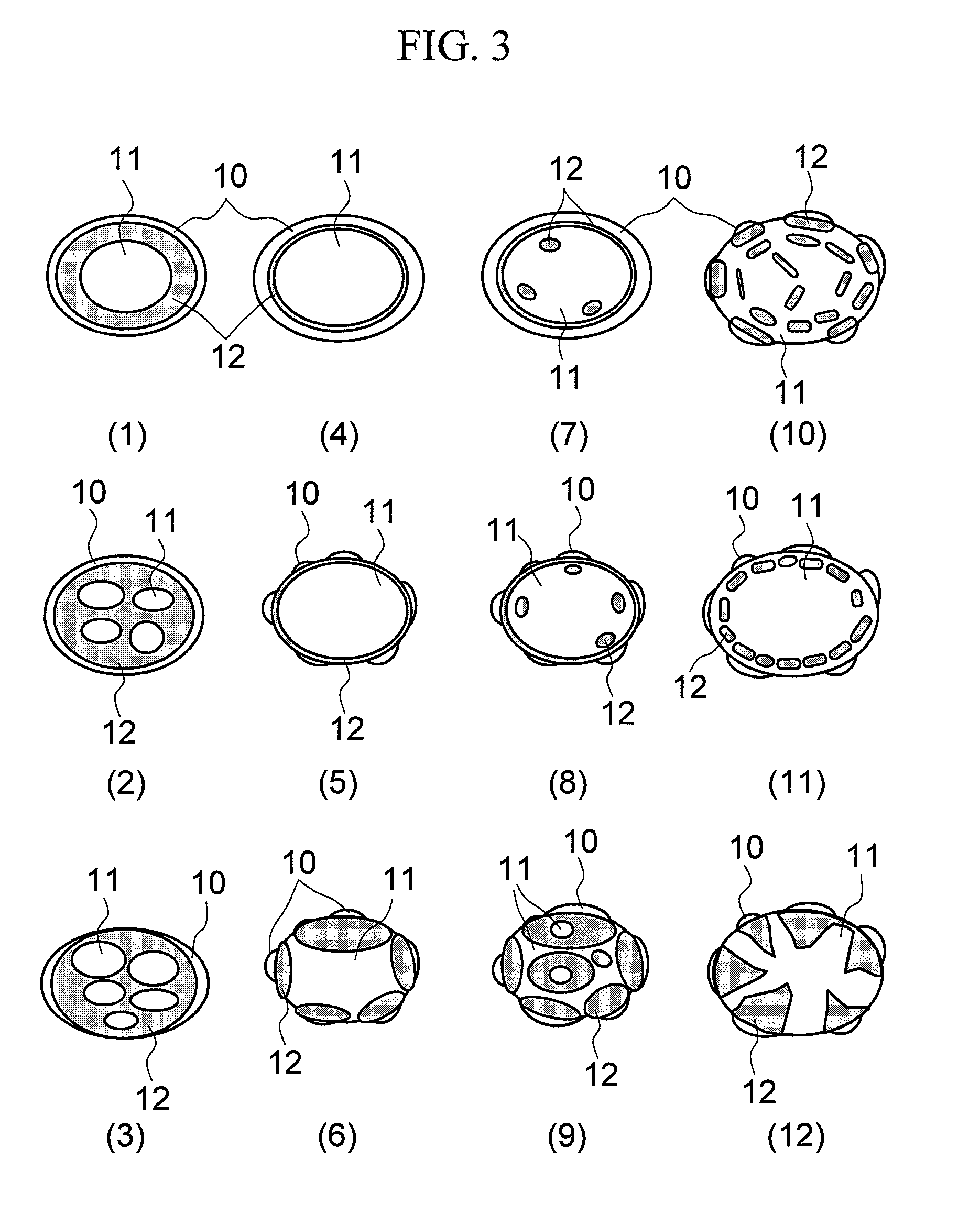Magnetic material and motor using the same
a technology of magnetic materials and motors, applied in the direction of magnetic materials, inductance/transformers/magnets, magnetic bodies, etc., can solve the problems of reducing coercive force, various types of defects, and not verifying the presence of fluorine in the main phase, etc., to achieve high coercive force, low iron loss, and high magnetic flux density
- Summary
- Abstract
- Description
- Claims
- Application Information
AI Technical Summary
Benefits of technology
Problems solved by technology
Method used
Image
Examples
example 1
[0066]In the present Example, a fabrication method of a magnetic material which has a phase of the central portion having a low fluorine concentration and a phase of the surface having a high fluorine concentration, and has a crystal orientation difference between the both of 45° or less in average, and a magnet using the magnetic material will be described.
[0067]In order to fabricate a NdFe12F magnet, a master alloy of Nd and iron are melted in vacuum so that the atomic ratio of Nd and Fe becomes 1:12. After the melting and cooling are repeated several times in order to homogenize the composition of the master alloy, the composition is again melted and quenched to form a foil piece of about 100 μm in thickness, which thereafter is pulverized in a hydrogen atmosphere. The pulverized powder has an average powder diameter of 10 to 100 μm.
[0068]The pulverized powder and an ammonium fluoride powder are mixed in an alcohol solvent, charged in a vessel with stainless balls whose surface i...
example 2
[0077]In the present Example, a fabrication method of a magnetic material in which the crystal orientation difference inside the magnetic powder can be made 45° or less, and magnetic characteristics of a magnet fabricated thereby will be described.
[0078]100 g of a Sm2Fe17N3 magnetic powder having a grain diameter of 1 to 10 μM is mixed with 100 g of ammonium fluoride powder. The mixed powder is charged in a reaction vessel, and heated by an external heater. The ammonium fluoride is thermally decomposed by heating, and NH3 and a fluorine-containing gas are generated. Through the fluorine-containing gas, some of N atoms in the magnetic powder start to be replaced with F (fluorine) at 50 to 600° C. In the case of the heating temperature of 200° C., a part of N is displaced with F, and Sm2Fe17(N, F)3 grows in which fluorine and nitrogen are disposed at interstitial positions in a Th2Zn17 or Th2Ni17 structure. By setting the cooling rate after the retained heating at 1° C. / min, some of N...
example 3
[0095]In the present Example, a fabrication process of a magnetic material in which a vapor-deposited Fe grain and a SmF-based alcohol solution are used; the fluorine concentration is different between the central portion and the surface and the difference in the crystal orientation is 45° or less in average, and magnetic characteristics of a magnet fabricated thereby will be described.
[0096]A vapor-deposition source is disposed in a vacuum vessel and Fe is evaporated. The vacuum degree is 1×10−4 Torr or lower; and Fe is evaporated in the vessel by resistance heating to fabricate a grain of 100 nm in grain diameter. An alcohol solution containing compositional components of SmF2-3 is applied on the Fe grain surface, and dried at 200° C. to thereby form a fluoride film of 1 to 10 nm in average film thickness on the Fe grain surface. The Fe grain coated with the fluoride film is mixed with ammonium fluoride (NH4F), and heated by an external heater. The heating temperature is 200° C.; ...
PUM
| Property | Measurement | Unit |
|---|---|---|
| temperature | aaaaa | aaaaa |
| curie point | aaaaa | aaaaa |
| angle | aaaaa | aaaaa |
Abstract
Description
Claims
Application Information
 Login to View More
Login to View More - R&D
- Intellectual Property
- Life Sciences
- Materials
- Tech Scout
- Unparalleled Data Quality
- Higher Quality Content
- 60% Fewer Hallucinations
Browse by: Latest US Patents, China's latest patents, Technical Efficacy Thesaurus, Application Domain, Technology Topic, Popular Technical Reports.
© 2025 PatSnap. All rights reserved.Legal|Privacy policy|Modern Slavery Act Transparency Statement|Sitemap|About US| Contact US: help@patsnap.com



